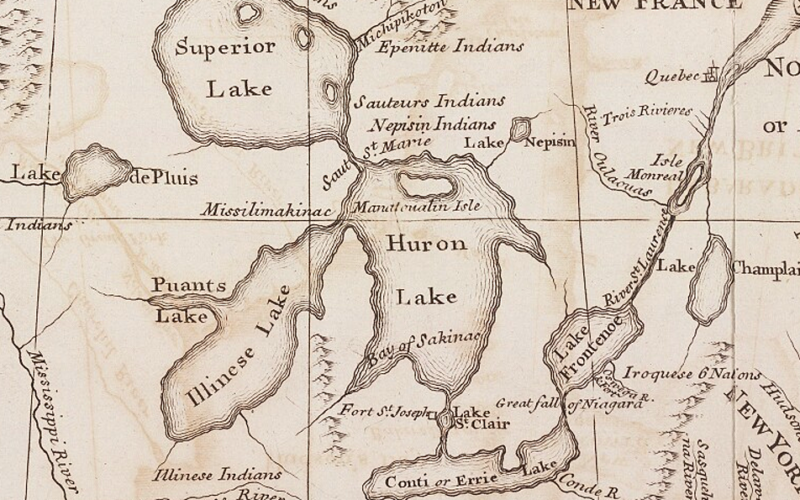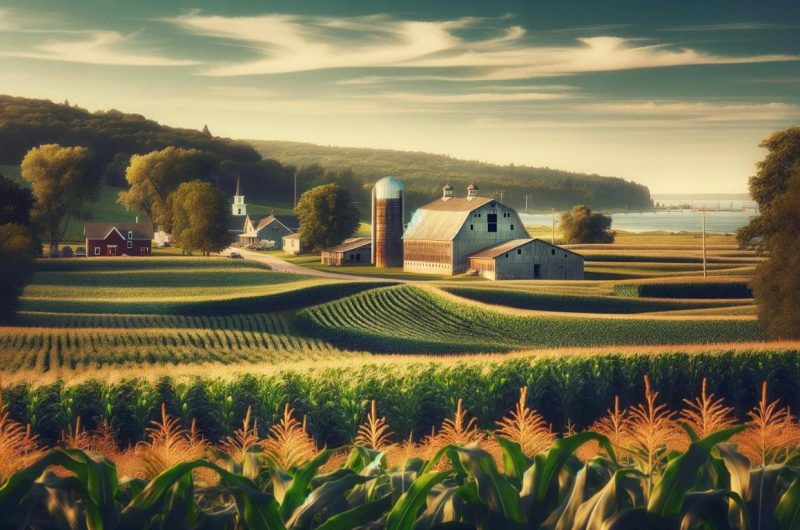The French Regime in the Upper Peninsula – Part Three

“Rural Voices” shares cultural, educational, economic and artistic views of people who have lived and thrived in the Upper Peninsula. Each of our authors in Rural Voices may be living here in the U.P. or living someplace around the globe, but the U.P. is an important part of who they are and what their beliefs and values are today. Rural Voices wants to share the voices of our neighbors and friends about life and experiences in the UP.
PART 3
Africans in the Colonial Era
The first Africans, both free and slave, entered New France and the Upper Peninsula beginning in the 17th century. They accompanied French traders and missionaries into the interior.
The first black slave to be clearly identified was Veronique, baptized in Ste. Anne’s Catholic church on January 19, 1743. She was the daughter of Bon Coeur (Good Hearted) and Marguerite. They were both slaves belonging to a voyageur, Sieur Boutin, who had been forced to winter at Michilimackinac on his way to the Illinois Country to the south. Other Blacks brought into the area remained there permanently.
Sieur de Vercheres, the commandant of Ft. Michilimackinac, owned Charles, who after religious instruction was baptized in January 1744. In 1762, the Jesuit priest Pierre du Jaunay held Pierre, a black slave, who was considered the property of the church. Under the French regime, slaves were used to carry out domestic chores or to help with the many facets of the fur trade.
French slavery differed from that of the British in a provision whereby slaves could be freed at any time and were integrated into the frontier community. Slavery continued after the French left in 1760.
Into the Mississippi Valley and the Great Plains
As the years passed, the French–through Indian informants–learned of the water routes and portages to the west and south and explored them. While at the mission of the Holy Spirit, Father Marquette had learned of the Mississippi River from an Illinois Indian who provided the inquisitive Jesuit with linguistic and geographical information about the route to the river.
In early 1673, Marquette was visited by Louis Joliet, whose instructions were to explore a route to the Mississippi with Marquette. In May, the Frenchman, Father Marquette, and accompanying Indians said farewell to St. Ignace and left for the west. Coasting along the Upper Peninsula shore of Lake Michigan, they headed south down Green Bay, up the Fox River, portaged to the Wisconsin River and soon were on the Mississippi River headed south to the Arkansas River.
There they returned north, but Father Marquette never made it back to St. Ignace. He worked for a while among the Illinois Indians, and eventually died in 1675 along the west coast of Lake Michigan. Marquette and Joliet pioneered an important water route from the Great Lakes to the Mississippi River. In 1682, Rene-Robert and Cavalier de LaSalle reached the mouth of the Mississippi and claimed the land for the French king, calling it “Louisiana.”
The French suddenly realized that they had an all-water passage from the St. Lawrence River to the Gulf of Mexico or following tributaries of the Mississippi River out into the Plains with Fort Michilimackinac as the gateway.
Trade possibilities onto the Great Plains were quickly recognized by Canadians operating through the Straits of Mackinac. As early as 1695, reports from the Apache detailing Europeans on the eastern Plains reached the Spanish in New Mexico, and in 1704 Canadians were on the Missouri River.
Nine years later a group of illegal French traders from Fort Michilimackinac arrived in Santa Fe, New Mexico, only to be arrested by astonished Spanish officialdom. Although New Orleans was established in 1718, furs continued to flow northward through Michilimackinac because the New Orleans humidity and heat ruined the furs.
As the years passed, a number of French forts were built along the Missouri River, creating a route onto the Plains. In 1720, the infamous Villasur massacre took place in Nebraska when a group of Oto and Pawnee successfully ambushed a large Spanish military expedition. Some reports indicated that the French were involved in the attack.
Étienne de Veniard, Sieur de Bourgmont, originally stationed at Detroit, had been living in central Missouri since the first decade of the 18th century. Here he had developed excellent relations with the Indians, especially the Pawnee and built two posts: Fort Orleans along the Missouri River and later Fort de Cavagnal built between Kansas City and Fort Leavenworth, Kansas.
Following these routes in the summer of 1739, Pierre and Paul Mallet left Fort Michilimackinac with eight or nine men and traveled across the Plains to New Mexico to develop trade with New Mexico, where the Spanish were in dire need of goods.
During the 1740’s with the end of Fox hostilities, the French began to move into the northwestern Lake Superior country. Pierre Gaultier de Varennes, Sieur de La Vérendrye (1685-1749) and his family of sons and nephews established themselves at Lake Nipigon and moved along the Canadian-Minnesota boundary. They encountered hostile Dakota who were furious at being by-passed as trading partners.
The Dakota attacked the French and were defeated and taken as slaves to Québec. Eventually the La Vérendyre party moved into South Dakota and probably came within sight of the Rocky Mountains. By 1742 French explorers had reached Alberta.
In June 1750, Jacques Le Gardeur left Montréal to continue the search for a route to the Pacific Ocean. He passed through Fort Michilimackinac in July and arrived at Fort La Reine (Portage la Prairie, Manitoba) in the fall and remained there for two years. It is said that Le Gardeur was the first person known to refer in French to the Stony or Shiny Mountains as Montagnes de Roche or the Rocky Mountains.
Documenting a few of the known explorers and traders who passed through the Straits of Mackinac on their way to the Plains illustrates the key role played by this Upper Peninsula settlement.
La Ronde and Copper Mines
The French tried their hand at opening and developing copper mines in the 1730s. Native Americans first introduced the French to Upper Peninsula copper in the 17th century. Louis Denis de La Ronde (1675-1741), a career French naval officer who in 1727 was made commandant at La Pointe on Madeline Island in Chequamegon Bay, learned of copper deposits on the Ontonagon River.
He was given permission to work these deposits in 1733 and developed elaborate plans to turn a profit. He constructed and operated a 25-ton vessel, the first ship to sail on Lake Superior, and expanded the settlement at La Pointe. Two German metallurgists arrived and declared the copper pure and manufacturable. La Ronde would employ fur traders idled during the quiet winter months.
All seemed to be going well for La Ronde until a war broke out between the Dakota and the Ojibwe in 1740. After La Ronde’s death in 1741 his family tried unsuccessfully to continue the project. It would be another century before copper in the Upper Peninsula would be rediscovered and mined.
Repentigny and Farming at the Sault Ste. Marie
In an effort to block British movements into the Lake Superior country, the French government took action. On October 18, 1750, Louis Le Gardeur de Repentigny (1721-1786) and Louis de Bonne de Missègle (c1717-1760) were given a land grant at Sault Ste. Marie to establish a farm and fort as a deterrent to the British advances.
The two men brought up Jean-Baptiste Cadotte as their superintendent along with a number of Indian slaves to work the land. However before much could come of this endeavor, the French and Indian War broke out and Repentigny and Bonne were recalled to fight.
Because nothing ever came of this land grant, in 1868 the Michigan Supreme Court ruled against the Repentigny family who sought to have the city of Sault Ste. Marie returned to them because of the earlier grant. The court ruled that Repentigny had never really established himself there and thus he never had a claim to the land.
Cultural Developments
The earliest cultural developments in the Upper Peninsula were meager, since the only literate individuals were the missionaries and the military. The early explorers unfortunately left few if any records. The Jesuits developed the first rudimentary schools in the Upper Peninsula, where they taught Indian adults and children religion and some basic subjects such as music, reading and writing.
These priests were educated beyond their religious training and wrote about the land and its people. The accurate map of Lake Superior developed from canoe-board notes and published in 1671 is an example of their scholarship, which is found in The Jesuits Relations and Allied Documents.
The Jesuits wrote about the environment of Lake Superior. Father Marquette and others first told Europeans of wild rice, maple sugaring and blueberries as an example. Since they needed to learn native languages to gain converts, many of the Jesuits developed grammars and dictionaries in their spare time. Louis Nicolas, S.J. was in New France from 1664 to 1675 did both.
He was interested in the Algonquin language and the natural life of his environment. He ventured into the Lake Superior country and was stationed at Sault Ste. Marie, where he gathered data on the Indians, animals, and plants. His Algonquian grammar was never published, but his Codex Canadensis was finally published in 2011. Father Du Jaunay at Michilimackinac in the 1740s compiled a 396-page manuscript dictionary of the Odawa language.
These priests carried with them small portable libraries of books of a theological, philosophical, and spiritual nature along with self-help works.
As has been pointed out, the fur traders were chiefly illiterate, and if they could write they did not have the time to keep journals or develop correspondence. The French military like Commandant Cadillac and others have left details reports and records.
Craft Industries
The usual view of the history of the Upper Peninsula concentrates on exploration, the fur trade, evangelizations, and interaction with the Native Americans. The lack of obvious population centers tends to negate any idea of community activities such as craft industries. Nevertheless there were concentrations of people—Native Americans, métis, French and English—at Sault Ste. Marie, St. Ignace, and Fort Michilimackinac.
These people needed a variety of items, especially since they were far from supplies in Atlantic port cities. As a result, local craft industries produced items in a volume beyond single household need and use. The items produced were sold, traded or given away. Thus the history of craft production–the forerunner of Upper Peninsula industry–goes back several hundred years.
There were no independent, full-time craftsmen at the Fort. Craft industries at Fort Michilimackinac were carried out as sidelines to one’s full-time occupation, usually fur trading. Skilled men and women repaired items critical to the success of the settlement. Full time craftsmen were first hired by the Jesuits, then the military, and finally by the colonial Department of Indian Affairs.
Historical documentation and archaeology give evidence of such craft industries as food production; metal, stone, and wood fabrication and repair; boat repair and production of naval stores; and clothing and moccasin manufacture and repair.
Food production was an important industrial activity involving both Native and European segments of society. The most ancient food production activity was making maple sugar, a highly nutritious food stored and used. Native Americans began maple sugaring in prehistoric times and continued during the colonial period, when the practiced was adopted by French Canadians. By the late 1760s they found that maple sugar was cheaper and more wholesome than Caribbean sugar.
Corn was cultivated by the Odawa and Huron at St. Ignace and later by the former at Cross Village to the southwest of modern Mackinaw City. It was boiled with lye made from ashes to easily remove the husks. This form of hominy was ground or pounded into flour which allowed easy storage. Corn was commercially traded to the French and English.
Alcoholic beverages could have been produced in the region. Spruce beer was common in colonial North America among the French and English. The anti-scurvy benefits of this beer were important to the British military. So it is not surprising to find evidence of its production and use in the Upper Peninsula. Spruce beer was made by processing spruce boughs, molasses, and water. In the late 1740s spruce beer was commonly used by French Canadians. In 1780 there was a commercial shipment of spruce boughs shipped from Fort Michilimackinac to Montréal to presumably make spruce beer.
A local grape common in the Upper Peninsula made wine and brandy production—not mentioned in the records and reports—likely. At Grosse Pointe, a suburb of Detroit, French habitants made wine and fermented brandy from local guignolet grape-like berries. Fruit trees–apple, pear, cherry and plum–were introduced by the French and their harvest could have used for wine making.
Commercial baking was carried out by the French and English at Fort Michilimackinac. There is evidence that in the 1770s a baker was paid at the fort. A 1749 map shows two bake ovens at the fort while the Jesuits had their own oven adjacent to their property. There was a demand for bread by the military at the fort, and hardtack was made for voyageurs and traders preparing for travel.
Metal work was an essential and important trade at Fort Michilimackinac. The Jesuits were given a monopoly over blacksmithing as a source of revenue for the missions. After the Jesuits left, the blacksmith who repaired guns became a part of Native American relations.
The first important blacksmith, Jean-Baptiste Amiot, worked at Michilimackinac between 1727 and 1763 first for the Jesuits and then for the military. Pascal Soulard and Michel Girard (listed as an “armourer”) worked for them as well. In addition to gun repair, they also produced darts, hoes, tomahawks, ice cutters, animal traps, buckles and awls, and mended daggers, swords, and kettles, all of which brought them a good income.
When Pierre-Joseph Céloron de Blainville planned his military expedition against the Chickasaw in Mississippi in 1739, Father Du Jaunay provided him with corn and ironwork.
When the British took over in 1763 they also found the need to repair Indian guns, to keep the Indians supporting the British. A fellow by the name of Allen Wangs appeared in the records as an Indian “smith.” This could mean either a British blacksmith who worked for the Indians or an Indian blacksmith. Later in the 1780s when the British were constructing Fort Mackinac on the island they needed many nails and employed blacksmiths.
Copper and brass were worked in the Upper Peninsula. Brass wire was a common trade item, fashioned by Native American women into snares to trap small animals and by Native men into tweezers to remove face hair. Tinkling cones or bells were very common and in demand.
There were also sundries and adornments: rings, arm and wrist bands and ear bobs. In 1721, Father Pierre Charlevoix, S.J. wrote of an unnamed Jesuit priest at Sault Ste. Marie who had been a goldsmith before entering the order made copper candlesticks, crosses, and other items from the pure copper found in the Lake Superior basin.
Other materials worked and crafted included lead for shot, toy whizzers, crude pencils, fish net sinkers, and brooches. Pipestone was made into pipes or calumets and scraps were made into beads and pendants. Whetstones were produced locally. Stone masons were on site to work on and improve a variety of buildings.
Wood was used for construction and repairs of buildings; for making furniture too costly to ship; and for making barrels—in great demand for shipping goods. Animal skins were used to make clothing and moccasins. Bone was used to make dice, buttons, harpoons, and wampum
The French soldiers stationed at Fort Michilimackinac had a great deal of “fatigue time.” They applied this time and their individual skills on a variety of projects. They made wheelbarrows to remove sand drifts. Some of the soldiers were assigned to fish to supplement the garrison’s provision stores, so nets had to be made and repaired. The soldiers also had to cut wood for heating, for construction and to make charcoal to burn lime.
End of the French Regime
The Seven Years War or the French and Indian War officially in 1755 and the population of the Upper Peninsula became involved in the struggle. In July, Charles Langlade led Indians from Michilimackinac to aid French forces at Fort Duquesne (modern Pittsburgh) in routing Major General Edward Braddock.
In 1756, the Menominee under Coulon de Villiers fought the British along the Oswego River in New York. Despite a smallpox epidemic (July 1-13), the Menominee traveled to Montréal and met Governor de Vaudreuil. In August 1757, a force of Frenchmen and seventy Odawa under Langlade helped capture Fort William Henry on Lake George in New York.
During this war the British decided to use biological warfare as a means of killing Indians without endangering British soldiers. They spread smallpox by placing pox crusts on blankets that they gave to the Indians. An epidemic broke out in many areas, especially in the vicinity of Fort Michilimackinac between October and December 1757, with deadly results.
The war interfered with trade good coming from Montréal and hindered coureurs-de-bois from trading to the south. Trade was harmed. As a result the Ojibwe in the Upper Peninsula went north, accounting for twelve percent of canoe traffic reaching York Factory on Hudson Bay and continued between 1758 and 1761.
When the final battle for North America centered on Québec City took place on September 1759, Native Americans from the Upper Peninsula were on hand to provide the French with military support. Unfortunately they were not used, and on September 17th the French lost the battle of the Plains of Abraham. British troops entered Québec City, the key to the St. Lawrence River Valley and ultimately to the interior as well.
In the following year, Montréal, the last important French stronghold in Canada, fell to the British. Articles of capitulation were signed and the struggle for New France came to an end. The Upper Peninsula now passed to the British. The French inhabitants and fur traders remained, although the French officials and military left. The garrison at Fort Michilimackinac, commanded by Captain Louis Liénard de Beaujeu, to avoid the embarrassment of surrendering the fort to the British left the fort in the hands of Charles Langlade, climbed into canoes, passed along the Fox-Wisconsin-Mississippi Rivers and eventually made it to New Orleans, which remained in French control.
There they boarded French transports without having to deal with the British. North America and the Upper Peninsula were lost to the British with the signing of the Treaty of Paris in 1763.
Although the French military and officials left the region, the French settlers, voyageurs, coureurs-de-bois, and métis remained, as this was their home.
The Native Americans—staunch French allies—feared for the future. Would the British mistreat them and distribute smallpox infected blankets as they had done before? As the French left, they told the Indians to hope for a return of the French in the future.






Such excellent work! I have really enjoyed your three articles. Thank you Russell Magnaghi!
MaryEllen Weller-Smith
Thanks Russ, I’m always interested in UP history.
The history of this wild and beautiful place is intriguing, thank you for letting us enjoy it.
Great article. I l knew about half of this before reading, and what i learned was very interesting
Beautifuly put together ,I love reading the true story! I have found some of the very things you speak about